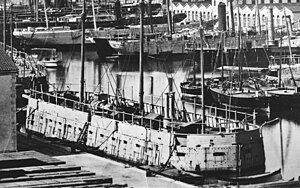HMS Trusty (1855)

Lave, one of the Aetna class's French half-sisters.
|
|
| Class overview | |
|---|---|
| Name: | Aetna |
| Operators: |
|
| Succeeded by: | Erebus-class ironclad floating battery |
| Built: | 1854-56 |
| In service: | 1855-73 |
| Building: | 6 |
| Planned: | 5 |
| Completed: | 5 |
| Lost: | 2 |
| Retired: | 4 |
| General characteristics | |
| Class and type: | Aetna class floating battery |
| Tonnage: |
|
| Length: |
|
| Beam: |
|
| Draught: |
|
| Propulsion: |
|
| Sail plan: | Three masts 885 m2 (9,530 sq ft) sail |
| Speed: |
|
| Complement: | 200 men |
| Armament: |
|
| Armour: |
|
The Aetna-class ironclad floating batteries were built during the Crimean War for the attack of Russian coastal fortifications.
Britain and France each laid down five of these coastal attack vessels in 1854. The French used three of their batteries in 1855 against the defences at Kinburn on the Black Sea, where they were effective against Russian shore defences. The British plan to use theirs in the Baltic Sea against Kronstadt in 1856 was influential in causing the Russians to sue for peace. The development of such iron-armoured batteries was a step towards the development of ironclad warships. "These armoured batteries were among the most revolutionary ships ever built and provided British and French designers with the germ of the battleship."
One of the British batteries, the Trusty, was used for trials in 1861 with a prototype rotating turret, based on Captain Cowper Phipps Coles' designs.
Emperor Napoleon III initiated the design of armoured steam-powered batteries for the French Navy. The original idea was to protect the sides with boxes of cannonballs, but the British engineer Thomas Lloyd suggested using thick wrought iron plates instead. Trials at Vincennes showed that Lloyd's idea was more effective, so it was adopted.
Napoleon wanted ten floating batteries built in time for the 1855 campaign, but as French industry could only build five in time, France's British allies were asked to build the other five. Unfortunately the First Lord, Sir James Graham, confused this concept with the unsuccessful iron-hulled frigates built in the late 1840s, and asked for further trials, so the British armoured batteries were not ordered until 4 October 1854.
These vessels were copies of the French Dévastation-class batteries. The French batteries carried 16 guns, but had 24 gun ports. The British Aetna class were also intended to carry 16 guns, but the first four completed only carried 14 guns to reduce draught to 8 ft 8 in (2.64 m). The Admiralty design drawing showed them with 32 gunports. These ports were very large - 34 by 40 in (0.86 by 1.02 m).
...
Wikipedia
